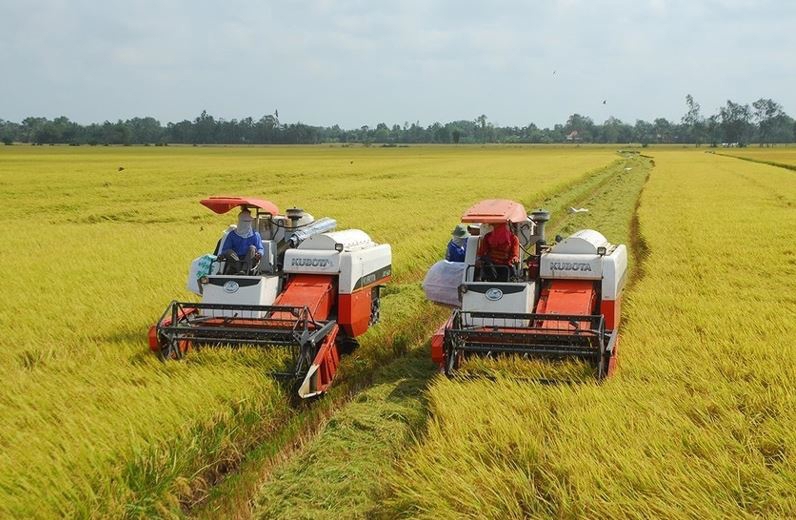Green Carbon Inc., which operates a nature-based carbon credit creation and sales business, has announced that its application for the VM0051 “Project for Methane Gas Reduction by Introducing AWD1 in Rice Paddies”, underway in the Mekong Delta’s An Giang province, was accepted and listed by the voluntary carbon credit standard Verra on April 1, marking a world first for this project type.
Smart solution for cleaner rice farming
Rice is a vital crop in the global food supply chain, playing a central role in ensuring food security for more than half of the world’s population.
Vietnam’s rice cultivation area was estimated at 7.13 million ha in 2024, with an expected output of about 43.46 million tons. This makes Vietnam the fifth-largest rice producer and third-largest rice exporter in the world. The role of rice production extends beyond national boundaries, reaching international markets and contributing to global food security amid rising populations and increasingly complex climate change challenges. Vietnam is currently viewed as a country with strategic importance in maintaining stable rice supplies for many nations, particularly across Asia and Africa.
While rice farming brings economic value and food security, it is also a significant source of greenhouse gas (GHG) emissions. In Vietnam specifically, rice farming has been identified as the cause of approximately 48 per cent of the agricultural sector’s GHG emissions and 75 per cent of total methane emissions from agricultural activities.
In addition to GHG emissions, rice farming also consumes a large volume of irrigation water. Studies have shown that water used for rice accounts for 34 to 43 per cent of total agricultural irrigation water use. In the context of increasingly severe climate change and rising water scarcity, traditional cultivation systems are facing mounting pressure. Continuing with constantly flooded farming models will make it difficult to meet resource efficiency goals and reduce emissions in agriculture.
The Alternate Wetting and Drying (AWD) irrigation method has been studied and implemented as a solution to improve water use efficiency while significantly reducing methane emissions from rice paddies. Instead of maintaining constant flooding, this approach allows the field to dry for short periods before re-irrigation. Research shows that AWD can reduce methane emissions by up to 47 per cent compared to traditional rice cultivation methods. Implementing water-saving irrigation enables farmers to maintain, or even slightly increase, yields without increasing water use, demonstrating the method’s viability in lowland regions where water is generally abundant but increasingly threatened by climate change.
Potential of AWD
An Giang belongs to an agricultural ecosystem comprising rice fields, industrial crops, vegetables, and, partially, forested areas. Local people are gradually shifting towards cultivating higher-value crops and engaging in aquaculture. Urbanization has led to the conversion of some agricultural land. The region has a tropical monsoon climate, characterized by year-round heat and humidity, influencing the cropping calendar.
To generate carbon credits, the project implements a rice cultivation model with improved water management practices aimed at reducing methane emissions, which result from anaerobic conditions under prolonged flooding. Among the key activities, the project applies the AWD method, clearly defined in the technical documents and applied consistently throughout project implementation.
The method demonstrates significant water-saving benefits, reducing water use by an estimated 15 to 35 per cent compared to historical averages. Studies confirm that, when applied correctly, this method does not compromise rice yields. The project does not implement any additional quantitative adjustments such as changes in fertilizer application or fossil fuel consumption. Its primary objective centers on water management and the control of field flooding conditions in rice farming.
The entire project area is equipped with an active irrigation system capable of managing water flow and volume according to technical requirements. The system ensures optimal conditions for reducing greenhouse gas emissions during the rice plant’s growth cycle. It is designed for flexible operation, allowing adaptation to specific irrigation demands at various times and crop development stages. The project’s activities are not restricted by any local legal regulations prohibiting the use of improved irrigation practices. A legal analysis and referenced documentation have been thoroughly reviewed to ensure compliance with the latest version of the Verified Carbon Standard (VCS).
The project is implemented in an area that has not been converted from a natural ecosystem within ten years prior to the project start date. Land use assessment documents clearly establish the stable and continuous use of the land for rice cultivation during the preceding period.
All rice-growing areas involved in the project consist of irrigated paddy fields under active water management systems, and do not include upland rice, rain-fed seasonal rice, or uncontrolled deep-water rice. The cultivation model does not rely on natural rainfall and is not constrained by uncontrolled water flow conditions. It does not interfere with management practices during the off-season. Activities such as tilling, fertilization, crop rotation, and livestock raising continue as they have historically. The project’s focus is solely on the rice-growing period. It does not include activities such as post-harvest straw burning or changes in water management before the planting season.
Agriculture, Forestry, and Other Land Use (AFOLU) activities with similar or identical characteristics to the proposed project, if previously implemented within the project boundary, whether or not they were registered under VCS, must comply with all effective legal regulations, even in cases where enforcement is weak.
The tool for determining additionality is only accepted when the baseline methodology follows a step-wise analytical structure, aiming to rationally demonstrate the most likely baseline scenario. Each step must be based on both quantitative and qualitative information to build a comprehensive picture of the project’s current state and development trends. Each assessment step must follow a clear internal logic and maintain consistency between baseline scenario identification and project additionality.
As a result, on April 1, 2025, Green Carbon Inc. successfully registered the “Project for Methane Gas Reduction by Introducing AWD1 in Rice Paddies” under the VM0051 “Improved Management in Rice Production Systems, v1.0” methodology from Verra’s VCS, effective from February 27, 2025. The project is designed to cover a cultivated area of 116,000 ha, applying the AWD method in strict accordance with technical processes and standards, and equipped with greenhouse gas monitoring and measurement systems to ensure transparency and carbon credit issuance capability. By installing AWD tubes in rice fields and accurately monitoring water levels, farmers can effectively control soil state transitions and maintain productive cultivation.
The project, in collaboration with local partners, has organized numerous meetings, technical training sessions, and awareness campaigns on the benefits of AWD, providing ongoing technical support throughout implementation. This has helped raise awareness and improve the practical capabilities of the farming community in adopting new techniques. The project aims to reduce an average of 590,682 tons of CO₂e annually, with a total emissions reduction of over 24 million tons of CO₂e during the first crediting period, from April 1, 2025, to March 31, 2032.
The project’s success contributes to greenhouse gas mitigation and opens up opportunities for carbon credit commercialization, helping increase farmers’ incomes and creating resources to invest in sustainable agricultural development.
(*) Associate Professor Nguyen Dinh Tho is the Director of the Institute of Strategy and Policy on Agriculture and Environment (ISPAE), and Mr. Jun Okita is CEO of Green Carbon Inc.









 Google translate
Google translate